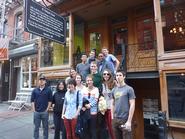
On Oct. 20 Hamilton’s New York Program students toured the Tenement Museum on the Lower East Side then took a one-hour walking tour of the neighborhood.
The group met their first tour guide, Lorinne, just outside of the museum, a landmark building built as a tenement in 1863 by Louis Glockner. Before entering, Lorinne provided background on the area, an iconic immigration spot due to the influx of immigrants from the mid-1800s through World War I. She then led the group inside through a dimly lit, narrow corridor and up rickety wooden stairs with paint chipping off the walls.
The first stop was a 325 square foot “apartment” from the mid-1800s that housed, on average, four to five people. The space had no indoor bathroom, running water or electricity and heat could only be generated through using the coal oven. After pointing out these conditions, Lorinne shared the story of the Gumpertz family, who lived there during the Panic of 1873. The group then crammed next door in a slightly smaller apartment from the early 1920s that housed, on average, eight to 10 people as the number of immigrants had continued to rise. This space had running water, electricity (a single light bulb hanging from a chain), and a gas burner. After pointing out these differences, Lorinne recounted the economic struggles of the Baldizzi family who lived there going into World War I.
Both stories were touching and exemplified the difficult living conditions, menial job options and economic woes most immigrants faced coming to America during the Great Wave of immigration. When asked why they would move to endure such a life, Lorinne explained that at the time, being poor in America was better than to be so in their home country because at least there was a ladder out of poverty here (a prominent theme in one of the program’s courses). She left the students with the questions: Is there still a ladder today as government cracks down on immigration policies? And if there is not one, how will this affect immigrants’ experience in America?
The group then joined Ryan Lockwood, another tour guide, who walked them through the Lower East Side. The first stop was Orchard Street where Ryan showed a picture of it from 1898 for dramatic effect. Then, the street was crowded with hundreds of people at a street fair. Now, it is deserted and lined with Asian hardware stores and an Asian real estate broker. Along the walk, Ryan also pointed out a few landmarks that were erected in the late 1800s in response to the immigration influx. These included Jarmulowsky bank, where all transactions were in Yiddish, Forward Building, which was headquarters for a socialist Jewish-American newspaper, and P.S. 40, which is a public school that was founded in 1898 on the mission to Americanize children.
The tours were followed by a delicious lunch at Katz, which is an iconic Jewish deli/restaurant on the Lower East Side. There, the students enjoyed Matzo ball soup, pastrami sandwiches and cheesecake, among other tasty options. Throughout the meal, they looked at the walls that are covered with framed pictures of celebrities who have eaten there.
Posted November 20, 2012
